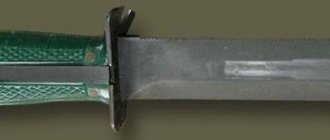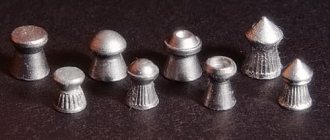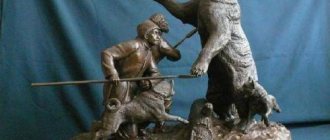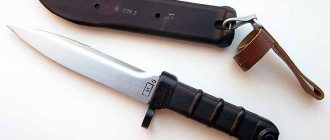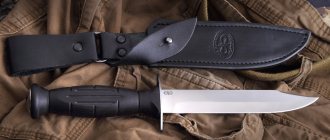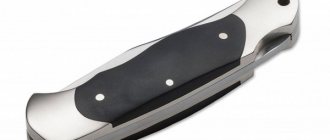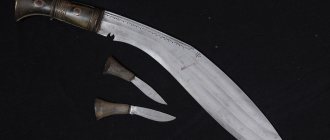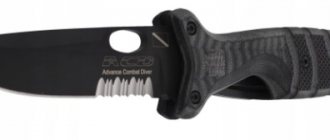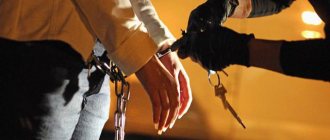Ballistic knives
Ballistic knives.
Continued It is very difficult to realize the potentially good damaging capabilities of throwing weapons in practice. The probability of a fatal injury is low, and one cannot count on such a knife as a serious weapon. It’s another matter if a person’s strength and dexterity are replaced with a mechanism, for example, making a blade shoot. This knife has a clear tactical advantage. The enemy simply does not expect that a blade might fly at him. In addition, throwing a knife is not convenient from any position. For example, it is quite clear that throwing while standing is much more effective than throwing from a prone position. But you can shoot a knife with equal success from any position. Here everything depends on the convenience of aiming, since the damaging factors, firing range and the force with which the blade hits the target are constant. Knives from which the blade flies out are usually designed like spring crossbows. This design is the simplest, and therefore more reliable. The historical prototype of shooting knives can be considered a Chinese secret weapon, which consisted of a bamboo tube, a powerful spring, an arrow and a trigger mechanism. It was worn in the sleeve and made it possible to suddenly hit a target at a certain safe distance. Conceptually, this design is almost no different from a modern shooting knife. All that remains is to replace the arrow with a blade, or more precisely, to increase the size of the arrow tip so that it can also perform the functions of a knife. The versatility of such weapons is attractive. This is an ordinary knife that can both stab and cut, and if necessary, instantly and suddenly turns into a throwing weapon for the enemy. This knife is relatively silent in use, although a spring knife can hardly be called a completely silent weapon. The clang of metal on metal, the ringing of a straightening spring serve as unmasking factors, but against the background of natural noise such a shot is almost indistinguishable. Undoubtedly, a spring shooting knife is much more effective than a throwing knife, although it is much more complex in design. Why have spring knives never gained much popularity? The answer is that their area of application is special operations. Similar knives were in service in many countries of the world: the USSR, the USA, Czechoslovakia, France, Switzerland and many others. Quite little is known about the design: intelligence agencies do not really like to reveal their secrets. The shooting spring knife could be either single-shot or multi-shot. The maximum range of destruction is no more than 5-7 m, although rumor ascribes the ability to hit the enemy at a distance of 25-30 m. The discrepancy is due to a lack of understanding that the flight range of the blade and the range of destruction are different distances. At a distance of 5-7 m, with a successful hit, the blade will enter its entire length and cause a serious injury, and a hit from a distance of 25 m will only result in slight damage to the skin. Hence, one of the disadvantages of such knives is their short range, but they are melee weapons. Much more significant is that first the knife shoots, the blade flies away, and then, in hand-to-hand combat, only the handle remains in the fighter’s hands. There may not be enough time to reload the knife with a spare blade. They are trying to solve this problem in different ways. The simplest option is to use the handle itself as a weapon. To do this, it is joined to a massive metal sheath to be used as a short baton. In addition, a durable metal sheath is an additional safety feature that increases the safety of using this weapon. In other knives, the blade is placed on a sharpened pin. After the shot, the pin, rigidly fixed in the handle, can be used as a stiletto. At the same time, the pin serves as a guide for the mainspring.Multi-charge knives solve the problem more easily. The last blade is not fired, but remains in the handle, and the knife becomes ordinary. For example, when a double-blade knife with one mainspring is fired, one blade flies forward under the action of the spring, and the other simply extends and is fixed in the firing position. Naturally, these blades have different designs. In practice, they often use one blade, the design of which allows it to be used for both shooting and hand-to-hand combat. But this decision is not so much constructive as economic. A knife with a utility blade is a little cheaper. In single-shot designs, a special non-firing blade is used, which can be mounted on the handle, made more massive and longer. But it takes some time to place the blade. But the biggest problem is the low stopping effect of such a knife, which is very important for weapons that are fired almost point-blank. A spring-loaded shooting knife is a very controversial design. On the one hand, it must have a relatively small size and weight, and on the other, it must have the necessary fighting qualities. A spring that is too powerful is difficult to place in the handle of a knife and difficult to cock, since human physical capabilities are not unlimited. Let us remember that such a knife is almost no different from a crossbow, on which special devices are used for cocking. A tighter spring is not only more difficult to compress, but the overall reload time increases. That is, the already low rate of fire of the knife decreases even more. In addition, a spring knife is potentially dangerous: it is always loaded, and when performing normal functions there is still a danger of an unauthorized shot. Therefore, they are equipped with reliable fuses, the simplest of which is a pin with a ring, like on a hand grenade.
A ballistic knife is a special knife with a detachable blade. Moreover, it does not just separate, but is fired at high speed (about 16 m/s), causing serious damage to the enemy at distances of up to 10 meters. A regular knife strike has a much lower speed.
The idea of the knife inventors is quite simple and understandable: to create a weapon that could be used not only in close combat, but also to defeat (and silently) an enemy at a distance.
Agree, a knife shooting with a blade looks too “cinematic” to be truly effective. Few other bladed weapons are surrounded by such an aura of rumors, speculation and innuendo. But at the same time, ballistic knives do exist; moreover, there is information that at one time special services of the USSR and the USA worked on improving these weapons. In 1986, ballistic knives were even officially banned in the United States. True, the effectiveness of their practical application raises many questions. However, let's talk about everything in order.
What is a ballistic knife? How does this “miracle weapon” work? Is it used in the military or special forces?
What is a ballistic knife
Since the advent of gunpowder and the era of firearms, throwing weapons have not lost their relevance. The bow and crossbow continued to be in service with medieval armies for a long time, along with arquebuses, muskets and arquebuses. However, in close combat, preference was given to melee weapons. Swords, sabers, rapiers and broadswords were the main weapons of cavalry and rifle units on the battlefield. As for effective weapons for self-defense, knives, stilettos and daggers have been and remain the most reliable means of fighting in direct contact with the enemy.
All of the listed types of bladed weapons are used in open confrontation with the enemy, when the damaging effect is the result of a person’s physical efforts. The larger the blade of the knife and the sharper the blade, the greater the physical damage inflicted on the opponent. Melee weapons are great for close contact with the enemy, but can also be used at a distance. It is not without reason that some types and types of knives have a shape and design specially adapted for throwing, but situations often arise when a blow must be struck covertly, at a distance and without visible effort.
Melee weapons, which have a blade or blade that can be detached and fired, are not a new invention. There were attempts to design a knife in which the throwing action was carried out by igniting a powder charge, but during use there was no talk of stealth. The main task that designers and inventors set for themselves was discreet application. Using such a weapon for an attack, it was important to achieve the effect of surprise.
A knife that has a blade that shoots is called ballistic. Why? The thing is that the flight of the blade follows a ballistic trajectory. More modern designs of products of this type were equipped with springs. In later versions, the ballistic knife already had a device that fired the blade under the influence of compressed gas. The weapon had the following operating principle:
- the blade is fixed in a hollow handle;
- the fighting mechanism is represented by a powerful spring or piston;
- in models with gas action, a gas cylinder is placed in the handle;
- the release mechanism has a lever that locks the blade in a hidden position;
- the pin or pin is a safety device, keeping the blade from unintentional launching;
- pressing the lever releases the latches, after which the blade flies out of the handle.
Despite the simple and clear principle of operation, the effectiveness of such weapons has a number of controversial issues. The main advantage of knives with a flying blade is that the blow is delivered at a distance. In this case, the impact force is much greater than with a regular knife throw. A priori, the triggered mechanism should not make any sounds. Practical experiments have shown that a flying blade is stuck into a wooden board to a depth of 3-4 cm. When used correctly, this is enough to cause significant physical damage to the enemy.
Note: Ballistic knives that have a mechanical operating principle cannot be called silent weapons. The action of the triggered spring, manipulation of the latch and operation of the release lever are accompanied by a loud clanging sound.
The disadvantages of this type of throwing weapon are the presence of noise when the spring mechanism operates and the fact that after the blade is fired, the knife in the hands becomes a useless object.
The ballistic knife was not spared from other disadvantages characteristic of all products with a mechanical warhead. The spring mechanism requires constant discharge, so such weapons need to be constantly cocked and reset. Otherwise, the spring will be deformed and lose its dynamic properties. Another drawback to shooting knives is the potential for unintentional injury or injury upon close contact. If handled and used improperly, the products are very sensitive to contamination and are susceptible to corrosion.
Advantages and disadvantages of ballistic knives
The idea of a blade flying out of a knife looks really nice and quite tempting, and it is likely that this weapon gives its owner some advantages in a duel. Why are ballistic knives still not the usual weapon of spies and saboteurs of various stripes and calibers?
One of the main advantages of this weapon is its greater versatility compared to a conventional knife. Not every knife is suitable for throwing, and throwing it correctly is a whole science. And here he pressed the button and “killed” the adversary. In this regard, the ballistic knife looks much more attractive.
The second advantage of this type of weapon is its power. According to various sources, the blade released from a ballistic knife can penetrate a board to a depth of 40 to 100 mm. This is more than enough to damage the vital organs of the human body. And the range of destruction of a ballistic knife is also quite impressive; various sources indicate 6 and even 10 meters.
Another advantage of a ballistic knife is the “effect of surprise” for the enemy. Such weapons are not very well known and widespread, so it is unlikely that your opponent will be ready for the blade flying out of the knife and, therefore, will not be able to react to it in time.
This is probably where the advantages of this type of bladed weapon end. The disadvantages begin. There are not that many of them, but the quality of the disadvantages of shooting knives fully explains why they are still not in service with the army or special services.
First of all, there are big doubts about the reliability of the knife mechanism, which, judging by the stated characteristics, should be quite powerful. At the same time, the creators of such weapons need to ensure their safety for the owner and reliability during use, which is not so easy to achieve. Using the energy of a compressed spring to fire a blade is not a very good technical solution. The fact is that a spring, being in a compressed state for a long time, loses its properties and needs to be changed. And the use of various compressed gases for shooting seems quite complicated and not very reliable. Reloading such weapons raises many questions. When using such a powerful spring, inserting a new blade into the handle is a serious problem that only a physically strong person can solve.
In addition, the ballistic properties of such blades are highly questionable. The accuracy of this weapon seems highly questionable. In this regard, the design of the Soviet NRS-2 knife, which fires special cartridges, looks much more reliable and effective.
It is also unknown how sensitive a ballistic knife is to various contaminants, and whether they affect its “shooting” functions.
And finally. One of the main disadvantages of a ballistic knife is its “disposability”. A single shot - and you have no knife at all, neither ordinary nor ballistic. In this regard, the same NRS-2 looks much more preferable.
In the twentieth century, the military experimented a lot with edged weapons, trying to give them a “new breath”. The Americans, for example, have been working for quite a long time on creating small crossbows for the needs of special forces. These developments ended quite successfully: their result was the creation of several models of crossbows that can be used in practice. However, despite the use of the most modern technologies and materials, they were significantly inferior to existing models of silent firearms. And we are talking about a crossbow - a weapon proven by centuries of practice. The same curiosity as a ballistic knife, in terms of its effectiveness, cannot be compared with an ordinary silent pistol.
According to the stories of a war veteran who served in intelligence, they were used at the end of the Second World War. Several blades were inserted into the handle, like into a clip, with the help of which it was possible to silently and remotely remove sentries. The last blade was not fired, but was fixed in the handle for hand-to-hand combat.
My father kept exactly such a handle, but without a knife, in a drawer of a bookcase, which was locked with a key.
In the 80s, a ballistic knife appeared in the USA, which, if necessary, could fire a shot with its blade. This bladed weapon was intended for the army, but it was soon abandoned and even banned. The American soldier is not accustomed to hand-to-hand combat; he fights exclusively with bombing, including atomic bombing, as in Hiroshima. And with a knife, and even one with a spring, he can cut his finger or something else.
The knife had an extremely simple design. Its handle contained a powerful spring, which, if necessary, pushed the blade out.
These knives were designed as silent weapons. They can be used as regular ones, without removing the blade from the handle, or as throwing ones. To throw a knife, you need to pull the lever and press the button (other options are possible depending on the design of the particular knife).
The spring inside it is capable of throwing a blade 6-7 meters at a speed of 60 km/h (~16 m/s).
Advantages
The advantage of this type of knife is that it can be used at a distance, and with a force more powerful than just a blow or throw of a knife, however, after firing the blade, the fighter remained unarmed, so it is necessary to have at least two knives in stock. When fired, the blade of a ballistic knife can go 35-40 mm deep into a wooden board, this is more than enough for the blade to reach the vital organs of a person.
Combat use
Army special forces use a ballistic knife to silently destroy enemy personnel. Since the goal of army special forces is to eliminate the enemy without unnecessary fuss and fuss, the enemy must be hit in the most vulnerable places. The shot is usually fired in the neck area for two reasons:
The neck, as a rule, is not protected by personal protective equipment (body armor, unloading vest, or even just thick clothing).
A hit in the neck will at least paralyze the enemy, preventing him from raising the alarm.
If a shot in the neck is difficult or impossible, other vulnerable spots on the enemy’s body are used. This could be the chest - usually this is the area of the heart, however, even a direct hit to the heart with a knife blade does not provide a 100% guarantee that the enemy will die immediately and will not be able to scream. A shot in the solar plexus or in the lung area is possible if the enemy is without protective equipment.
Experts note that, due to the unstable flight of the blade, the effectiveness of such weapons is limited to close combat, where a reusable knife would be more useful.
At one of the arms markets in the States, the seller of ballistic knives from the Czech factory Mikov (photo above) (which may or may not be in service with the special services) pressed the wrong button and drove the blade into his eye. And then he squinted his eyes - in every sense of the word. This is equivalent to a grenade in the paws of a monkey.
A ballistic knife is a knife with a detachable blade that is inserted into the handle and, under the influence of gas (or a spring), flies out of it at a speed of more than 60 km/h. Ballistic knives have been illegal in the United States since 1986. Use Ballistic knives produced in the USSR were intended for special forces soldiers.[ In the USA, ballistic knives appeared in the early 1980s. These knives were designed as silent weapons. They can be used as regular ones, without removing the blade from the handle, or as throwing ones. To throw a knife, you need to pull the lever and press the button (other options are possible depending on the design of the particular knife). The spring inside it is capable of throwing a blade 6 meters at a speed of 60 km/h (~16 m/s). Advantages The advantage of this type of knife is that it can be used at a distance, and with a force more powerful than just hitting or throwing a knife; however, after firing the blade, the fighter remained unarmed, so it is necessary to have at least two knives in stock. When fired, the blade of a ballistic knife can go 190-255 mm deep into a wooden board, this is more than enough for the blade to reach the vital organs of a person. Combat use Army special forces use a ballistic knife to silently destroy enemy personnel. Since the goal of army special forces is to eliminate the enemy without unnecessary fuss and fuss, the enemy must be hit in the most vulnerable places. The shot is usually fired in the neck area for two reasons: the neck, as a rule, is not protected by personal protective equipment (body armor, unloading vest, or even just thick clothing). a hit in the neck will at least paralyze the enemy, preventing him from raising the alarm. If a shot in the neck is difficult or impossible, other vulnerable spots on the enemy’s body are used. This could be the chest - usually this is the area of the heart, however, even a direct hit to the heart with a knife blade does not provide a 100% guarantee that the enemy will die immediately and will not be able to scream. A shot in the solar plexus or in the lung area is possible if the enemy is without protective equipment.
This is what is written in Wikipedia so briefly.
In general, a lot of nonsense is written about ballistic knives. A ballistic knife is a semi-mythical weapon of special forces and spies, which throws the blade over vast distances due to the energy of the mainspring hidden in the handle. I came across stories from “eyewitnesses” who saw with their shameless eyes how a Russian-made ballistic knife, Scout, pierced a concrete wall from a distance of 10 meters. Many experts on unknown animals are more modest in their assessments and point to effective defeat of the enemy from a distance of 5-7 meters. Finally, all sorts of pessimists and simply educated people note that, due to the unstable flight of the blade, the effectiveness of such weapons is limited in close combat, where a reusable knife will be more useful. At one of the arms markets in the States, the seller of ballistic knives from the Czech factory Mikov (photo above) (which may or may not be in service with the special services) pressed the wrong button and drove the blade into his eye. And then he squinted his eyes - in every sense of the word. Experts from the local forensic bureau decided to find out how lethal this weapon was, purchased a fresh corpse of a pig and began using this knife to stab at the corpse from different distances. The conclusion is this: when the distance to the pig was less than one meter, the blade was stuck into the corpse with its tip and penetrated into the tissue at a distance of 5-10 cm (they shot in the abdomen and chest area). At a distance of more than 1 meter to the target, the blade began to rotate and, at best, left superficial cuts. The total flight length was 25-30 meters. Conclusion - in close combat, such a ballistic knife produces penetrating wounds to a depth sufficient to damage vital organs, i.e. lead to death. However, the effectiveness of such weapons is quite questionable - the blade may not hit a vital organ, moreover, fatal wounds to the heart have been described, which left the victim 10-15 seconds of targeted activity. Wounds to the liver or lungs manifest themselves even more slowly, and a ballistic knife of a similar design is, by definition, one-time use (in combat). We are not talking about any 5-7 meters, and even more so about breaking through a concrete wall from a distance of 10 meters. That's it.
According to the stories of a war veteran who served in intelligence, they were used at the end of the Second World War. Several blades were inserted into the handle, like into a clip, with the help of which it was possible to silently and remotely remove sentries. The last blade was not fired, but was fixed in the handle for hand-to-hand combat.
My father kept exactly such a handle, but without a knife, in a drawer of a bookcase, which was locked with a key.
In the 80s, a ballistic knife appeared in the USA, which, if necessary, could fire a shot with its blade. This bladed weapon was intended for the army, but it was soon abandoned and even banned. The American soldier is not accustomed to hand-to-hand combat; he fights exclusively with bombing, including atomic bombing, as in Hiroshima. And with a knife, and even one with a spring, he can cut his finger or something else.
The knife had an extremely simple design. Its handle contained a powerful spring, which, if necessary, pushed the blade out.
These knives were designed as silent weapons. They can be used as regular ones, without removing the blade from the handle, or as throwing ones. To throw a knife, you need to pull the lever and press the button (other options are possible depending on the design of the particular knife).
The spring inside it is capable of throwing a blade 6-7 meters at a speed of 60 km/h (~16 m/s).
Advantages
The advantage of this type of knife is that it can be used at a distance, and with a force more powerful than just a blow or throw of a knife, however, after firing the blade, the fighter remained unarmed, so it is necessary to have at least two knives in stock. When fired, the blade of a ballistic knife can go 35-40 mm deep into a wooden board, this is more than enough for the blade to reach the vital organs of a person.
The birth of weapons and their scope
Today you can hear different opinions about where and by whom the ballistic knife was first invented. Some attribute the idea of creating a shooting knife to Arthur Conan Doyle, the creator of the immortal image of the English detective Sherlock Holmes. Others are betting on the authors of the film about James Bond, a British superspy who had a wide variety of weapons in his arsenal. The idea that the flying knife is the weapon of spies and detectives is undeniable. Another thing is that the ballistic knife really owes its appearance to the American intelligence services and the military department.
For reference: The prototype of the flying knife was an ancient Chinese invention. Back in the Middle Ages, weapons of this type were common in China. The bamboo tube was equipped with a powerful spring. The projectile was a shortened arrow with a long tip.
At the height of the Cold War, American engineers learned to create models of silent weapons that were equipped with intelligence agencies and special forces. Initially, it was planned that silent flying knives would become a convenient means for quietly eliminating the enemy, so the main focus was on developing a design suitable for sabotage units. Weapons are only effective when used correctly. The flying blade can only cause damage if it hits unprotected areas of the body. When attacked by an enemy equipped with basic body protection, the effectiveness of such weapons is reduced to zero.
One silent shot can hit an enemy at a distance of 10-15 m. The maximum effectiveness of combat use is achieved at a shorter distance. American samples showed good results during testing. From a distance of 5-7 m, a flying blade is capable of inflicting a wound 10 cm deep. The blow must be as accurate and true as possible. There is no time to reload a ballistic knife.
The emerging weapon models differ not only in their mechanism and operating principle, but also in appearance. Some knives are blade-shaped, while others have a short blade that more closely resembles an arrowhead. The only thing that all models have in common is the ballistic properties of the flying blade. The blade must fly along a smooth path and its cutting edge must be well sharpened.
As it turns out, it is quite difficult to realize the destructive capabilities of ballistic knives in practice. Anyone who plans to use such weapons for combat purposes must have the appropriate skills and dexterity. You shouldn't count on flying knives as your main and serious weapon. However, with enough training and experience, a fired blade can become the only “magic wand” that can solve the problem. In this case, we can talk about the tactical advantage that this type of weapon has. No enemy can be prepared for the fact that he can be covertly hit with cold steel from a distance. Ballistic knives can be used from any position, standing, sitting or lying down. In order to strike, there is no need to swing and apply some physical effort.
This weapon did not receive widespread use. This was facilitated by the limited scope of application of ballistic knives. In addition, special forces in any army today do not practice the use of flying knives in their work. An ordinary combat knife, finka or dagger is much more effective and useful in combat and in extreme conditions.
Knife design
The concept of a shooting knife has remained unchanged and is very similar to the principle of a crossbow. Unlike other common types of throwing hand weapons, a ballistic knife must be small in size. The main condition for the effective use of this product is secrecy. Neither the storage location nor the knife itself should be visible to the enemy.
The simplest and most common type of shooting knives are products with a spring mechanism.
In addition to its small size, the product must have a durable body that serves as a handle. Typically, the handle of a knife is made of brass, aluminum or copper. Stainless steel is often used for such purposes. The body is a tube, one end of which is closed with a stopper. The back of the handle should provide access inside to the operating mechanism.
The main working part of the device is a spring, the diameter of which corresponds to the diameter of the handle. Using a nut and bolt, the spring is attached to the back of the handle, so that after firing the spring is retained in the housing.
The knife blade is made of chrome-plated steel or another metal with good strength characteristics. The wedge shape of the blade is typical for knives. The finished blade is attached to the spring, and the attachment point must be movable so that the action of the trigger mechanism can provide the spring with simple ejection.
For ease of use, the product is equipped with a lock that holds the blade and the compressed spring in the loaded state. The trigger mechanism powers the ballistic knife. The design of the fuse and trigger mechanism occupies a special place in the products. The operation of both devices must ensure safe operation of the weapon and its effective combat use.
When making weapons, it is necessary to strictly observe the dimensions of all parts, taking into account allowances. In other words, in terms of assembly accuracy, such knives are very similar to pneumatic weapons, where the gas drive and spring mechanism are responsible not only for the ejection force, but also for the shooting accuracy. The knife blade should not be too heavy, otherwise the power of the spring mechanism will only be enough to push the blade out of the knife handle.
The production of weapons is not of a mass nature and looks like applied, handicraft art. In each individual case, the length of the blade and its weight are selected. The design of the knife itself is determined by the scope of application and efficiency. Modern products are weapons made of tool steel. The processing of parts and mechanisms is carried out using high-precision equipment.
By examining the scope of practical application of ballistic knives and their latest designs, we can conclude that a real alternative to pistols with a silencer has emerged. Despite the fact that a pistol is significantly superior in its firing characteristics to a flying blade, ballistic knives have a future. Here, what comes first is not so much the effectiveness of a weapon for close combat, but the legality of wearing it. Law enforcement will always have questions about a person carrying a combat pistol. For the owner of a knife whose blade is no larger than 90 mm, questions from law enforcement officers are already of a different nature.
Don't forget that a shooting knife is much easier to hide. A pistol, especially with a silencer, is a rather bulky and heavy product. Despite the fact that throwing knives are inferior to firearms in their combat capabilities, this type of weapon continues to be used by the secret services. Today, a ballistic knife can be found among combat swimmers who work mainly without firearms. Using a knife of this design for domestic purposes is unsafe, since ignorance of the principle of operation and inept handling can lead to injury.
If you have any questions, leave them in the comments below the article. We or our visitors will be happy to answer them
A ballistic knife is a special knife with a detachable blade. Moreover, it does not just separate, but is fired at high speed (about 16 m/s), causing serious damage to the enemy at distances of up to 10 meters. A regular knife strike has a much lower speed.
The idea of the knife inventors is quite simple and understandable: to create a weapon that could be used not only in close combat, but also to defeat (and silently) an enemy at a distance.
Agree, a knife shooting with a blade looks too “cinematic” to be truly effective. Few other bladed weapons are surrounded by such an aura of rumors, speculation and innuendo. But at the same time, ballistic knives do exist; moreover, there is information that at one time special services of the USSR and the USA worked on improving these weapons. In 1986, ballistic knives were even officially banned in the United States. True, the effectiveness of their practical application raises many questions. However, let's talk about everything in order.
What is a ballistic knife? How does this “miracle weapon” work? Is it used in the military or special forces?
Knife pistol and throwing stars: Russian special-purpose edged weapons
The history of special-purpose bladed weapons in Russia is truly multifaceted. The knife is an integral part of the “wardrobe” of special forces in Russia. However, it is surprising how diverse this wardrobe can be. The scouts themselves admit in conversations that if it comes to fire contact with the enemy, or, even worse, to hand-to-hand combat, then the operation can safely be considered uncovered.
However, the same special forces soldiers admit that sometimes, in certain cases and situations, “working with your hands” is still the best option. That’s when special equipment comes into play, neutralizing any enemy without noise or dust.
About history
The very concept of a “knife” was not new for the Soviet army - despite the fact that fighters were taught to use edged weapons in the heat of battle mainly together with a rifle, equipping firearms with so-called “bayonet knives”, the experience of handling edged weapons as a separate type of weapons the Soviet army had. As an independent combat unit in the hands of a soldier, the knife began to be actively used by Soviet soldiers during the Soviet-Finnish War, and reached its finest hour during the Great Patriotic War.
In those years, the situation on the fronts was such that quite often attacks from one side or the other ended in real bloody hand-to-hand combat, in which anything was used - from rifle butts and helmets to sticks and knives. It is no secret that some types of weapons, due to the lack of their own developments and, for the most part, due to lack of time, were simply copied in the Soviet Union from foreign ones.
One of the first Soviet knives NA-40, made on the basis of a uniform bayonet-knife of 1919, became just such a brainchild. They did not assign an unpronounceable name to the knife and the name was simply deciphered - Army Knife, and the number 40 meant nothing more than the year of adoption. It was the NA-40 that became the main working tool of Soviet soldiers in close combat, and also became a reliable ally for a good hundred units involved in sabotage operations.
An expert in the field of edged weapons and a master of artistic forging, Oleg Zvonarev, in an interview with Zvezda, told several interesting facts from the history of the Soviet knife: “As for this particular knife, it is a typical representative of good copying, and to be more precise, of good manufacturing based on existing samples.
The knife required minimal maintenance, the sharpness was maintained for quite a long time even under very harsh conditions, and in hand-to-hand combat the NA-40 could give odds to the best German blades. There were often cases when the Germans took knives from killed Red Army soldiers and subsequently used them themselves. It cannot be said, of course, that the knife was perfectly made - the handle sometimes flew off in the heat of battle, but this is the most serious thing that could happen to it then. Soviet intelligence officers, for example, called this knife an “arrow” because of the rapid lines, and in reports on the completion of the task they often wrote: “The object was hit by the intelligence officer’s arrow,” the expert said.
"Shurikens" of Private Torsunzhakov
The use of edged weapons by Soviet troops and special forces was justified - although there were devices for covert (silent) shooting, due to the insufficient development of technology, the shot was only partially masked, and, despite the significantly lower noise level, they still drew attention to the shooter . Edged weapons for forward detachments became a real lifesaver, but no one could even think that in addition to knives and bayonets, scouts would use... shurikens.
There is still no consensus on where the exotic Japanese star-shaped throwing knives came from. Some experts argue that shurikens appeared at the disposal of Soviet soldiers immediately after the Russo-Japanese War as trophies, while others argue that the little Japanese killers appeared only a year or two before the war. One way or another, shurikens did not receive widespread use due to the exotic nature of the “devices” themselves.
However, at the end of 1942, reports increasingly began to come from sabotage detachments in which shurikens appeared as a more lethal weapon than an ordinary Soviet knife. Historian and collector of bladed weapons, retired special forces officer Viktor Krasilnikov, in an interview with Zvezda, told where and by whom Japanese throwing knives were used: “The first shurikens, or rather, the first mentions of their use, date back to 1942-1943. Sabotage groups during the Rzhev-Vyazma operation then used them. They say that hira-shuriken (sharp four-pointed throwing “stars”) were made by one of the volunteers in peacetime and were simply lying around as an outlandish souvenir, however, with the onset of war, they were very useful.”
“With the help of shurikens, with proper skill, it was possible to easily “remove” the sentries without noise and dust. Private Red Army Torsunzhakov during the Rzhev-Vyazma operation generally distinguished himself by having a unique skill: he inserted shuriken into the area of the cervical vertebra of the Fritz and could instantly neutralize almost any enemy. I also heard about other cases of using shurikens, but there were more throwing knives than Japanese things made according to ancient designs.” - said the expert.
Scout's shooting friend
The post-war years became a real haven for weapons inventors of any kind - pistols, rifles and other deadly devices were invented by the dozens. Edged weapons, in turn, underwent only minor changes - and how can one develop an ordinary-looking knife, in which the main area for work is the handle and the blade? However, even in this case, Soviet gunsmiths had surprises prepared.
It is difficult to say for sure how exactly the idea of creating a shooting knife came to the mind of the Tula gunsmith Khlynin. Historians and experts in the field of unusual small arms claim that the influence was most likely the study of German trophies: such as a shooting buckle and other unusual shooting products. One way or another, the special scout knife (or NRS), developed by Khlynin, still remains, perhaps, the most unusual piercing-cutting and simultaneously shooting item adopted for service.
The creation of this type of weapon for the needs of the special forces of the Ministry of Defense and the KGB of the USSR made it possible to kill two birds with one stone: firstly, an effective object appeared with which a scout could operate even without a weapon, and secondly, an opportunity arose to study the practically untapped niche of special personal weapons in development which involved entire research institutes.
The head of the art forging studio and collector-historian Viktor Novopoltsev told in an interview with Zvezda some facts from the history of the most unusual knife in the world: “Since this knife is a combination weapon, this means that you can also shoot from it if you really press it. In order to not only cut, but also shoot, a small trigger mechanism was built into the knife, and for the shooting itself, SP-3 ammunition was used, which, in addition to the knife, is used in special silent pistols.”
“This is a special cartridge with a cut-off of powder gases, which is fired almost silently in a natural environment. The 7.62x38mm cartridge can kill at close range with a successful hit, and with a not entirely successful hit, it can almost mortally wound an enemy. In addition, in addition to the unique trigger mechanism, the knife is excellent for “field” work - planing wood, sawing through thin steel rods, “thorns” and other protective structures can be done with this knife without much difficulty - for such purposes there is a special file on the butt.”
My opinion is this: this tool was created not so much as a knife, but as a last chance for survival. Judge for yourself: cover the muzzle of the knife with a thick rubber curtain to prevent dust and moisture from accumulating, making the descent as simple as possible. Everything indicates that the creators did everything possible to ensure that the knife at the critical moment worked 100% like clockwork and did not fail. I’m already silent about the cutting qualities of the knife. With it you can easily survive in the taiga for some time.”
“I am often asked the question, why is there only one barrel for a knife? Well, the answer to this question is simple: as a weapon for the last shot, which decides the fate of the wearer, a knife does not need two barrels. I think the enemy will not allow you to fire a second shot in conditions of active shooting and combat in general. Therefore, it’s either hit or miss here. Although, on subsequent shooting knives, the ammunition was increased,” the expert said.
Combat "Chameleon"
Tula is the birthplace of unusual weapons. From anti-tank to cold - Tula gunsmiths do it all. In the 90s, already having some developments in the field of special weapons and equipment, a special four-shot shooting knife “Chameleon” was developed at the Tula Military Artillery School. In developing a new knife, Tula residents use their entire knowledge base - from the use of advanced materials for manufacturing to an extremely simple and reliable trigger mechanism design.
An expert in the field of small arms and special forces veteran Viktor Snegir, in an interview with Zvezda, shares interesting facts from the life of the Tula shooting knife: “I worked with it only a few times, but I can briefly describe it as follows: reliable, convenient, and will not let you down. The 5.45mm cartridges were taken from the PSM pistol. The “Chameleon” differs from the scout knife, firstly, in the amount of ammunition it carries for firing. There are four of them there versus one for the LDC. Well, so to speak, it increases the chances of survival. (laughs). But seriously, in addition to the good qualities of the knife blade itself, which can be used to saw, plane and cut quite hard, the knife can be disguised well as some unnecessary device and, if necessary, quickly snatched. Fortunately, the handle promotes a good grip. I know that there is also a modification for underwater combat swimmers. It already uses needle-type cartridges - like the APS assault rifle, for example. However, the land version of the knife turned out to be such that after a shot... from a distance of about 25-27 meters, the 5.45x18mm ammunition pierced a titanium plate 1.5-2mm thick. This, you know, is a very good indicator, which in combat conditions would guarantee hitting the target.” - said the expert.
Experiments on creating advanced weapons in Russia, in fact, never stopped. It is reliably known that even in the difficult 90s for the country, the development of shooting, special, small-sized and tactical knives for special forces of the army and navy was in full swing. With a high degree of probability, it can be argued that the developments and results obtained during this period will form the basis of a new combat edged weapon for Russian special forces. And something suggests that the demonstration of advanced special-purpose edged weapons for the Russian army is a matter of the near future.
Author: Dmitry Yurov
Description
The secret of the ballistic knife is quite simple. A special mechanism is inserted into its handle, which is a very powerful spring or a container of compressed gas, due to which the blade flies out with great force in the desired direction and hits the enemy. On the handle of a ballistic knife there are various types of locking devices that ensure the retention of the blade. To throw a ballistic knife, you usually need to press a button or pull a lever on the handle (depending on the design of the particular knife). All ballistic knives have symmetrical dagger-shaped blades with double-sided sharpening; they are often made with various cuts, probably to improve their ballistic characteristics. In general, the blades of such weapons are shaped like throwing knives, which, however, is not surprising. It is believed that the blade of a ballistic knife can hit an enemy at a distance of 6-10 meters and enter the board to a depth of 100 mm.
This is where the questions begin. How is the spring installed, how is it compressed when “loading” a ballistic knife? How reliable is the locking mechanism, does it provide the necessary security to the owner of this “device”?
Story
Ballistic knives first appeared in significant quantities in the United States around the early 1980s. Very quickly they became fashionable weapons. After all, a ballistic knife could be used as a regular one, and, if necessary, hit an enemy at a distance. It all ended with the Americans banning the sale and carrying of such weapons.
It still remains a mystery who first thought of making a knife of this design. Most sources report that this weapon was created for employees of special services or units, Soviet or American.
English-language authors usually claim that ballistic knives were first produced by the Soviet Union, although in this case it is not clear how they were able to get to the West at the height of the Cold War. In addition, an enterprise under that name never existed in the Soviet Union. And the very word “Ostbloc” seems, to put it mildly, strange: the “Eastern Bloc” in the USA and Europe was usually called the USSR and the Warsaw Pact countries.
The Soviet army never had such weapons in service; special units did not use them either. It is possible that some work has been carried out in this direction, but information about their application has not been found. And the reason for this is not the secrecy of the archives, but the highly controversial effectiveness of these weapons, which will be discussed below.
Soviet military intelligence (units of the GRU General Staff of the USSR) were armed with standard bayonet knives, the “Cherry” scout knife, adopted for service back in 1943, and the NRS-2 shooting knife, which probably became the source of the legend of the “terrible” ballistic knives of Soviet special forces. The only problem is that the NRS-2 shot at the enemy not with a blade, but with a bullet (special SP-4 cartridge) from a special device mounted in the handle of the knife. The Soviet special forces were armed with a sufficient number of silent weapons, which in their characteristics were significantly superior to any ballistic knives.
On the Internet you can find information about the Soviet (or Russian) “terrible” shooting knife “Infiltrator”, the design of which is not entirely clear, but its combat properties are simply amazing. This ballistic knife is reported to be capable of crushing brick and even concrete. But even in this case there is not much evidence base.
There is information (again, unconfirmed) that Tula gunsmiths were involved in the development of a shooting knife in the mid-80s. However, in their project, the blade was supposed to fly out of the handle not by decompressing the spring, but by using the energy of the powder gases. For this purpose, a special cartridge was installed in the handle of the knife. It seems that this project was a success, but the blade was never put into mass production. In this case, we are probably dealing with the usual distortion of information: we are talking about the Soviet shooting knife NRS-2, which really existed and was put into service. Both its creation and production were actually carried out in Tula. But he didn’t shoot with a blade, but with a special cartridge from the handle.
Domestic sources, as a rule, attribute the invention of the ballistic knife to US special services, which can be read about on many websites devoted to this topic. It is reported that such weapons appeared thanks to the developments of the American military department, which began in the mid-70s of the last century. Allegedly, the ballistic knife was supposed to go into service with American special forces and be used by them as a silent weapon.
Knife equipment
The shooting knife comes with a number of accessories. The kit includes:
- Accessory case.
- Insert for handle. Replaces the firing device in the handle. Allows you to practice techniques without worrying about the risk of deformation of the mechanisms.
- 2 pendants for wearing. One is waist, and the second is hip.
- Obturator. Serves to prevent the breakthrough of powder gases through the gap between the barrel bore and the projectile belt at the beginning of the shot.
- Ammo bag.
- Spring.
- Sheath.
